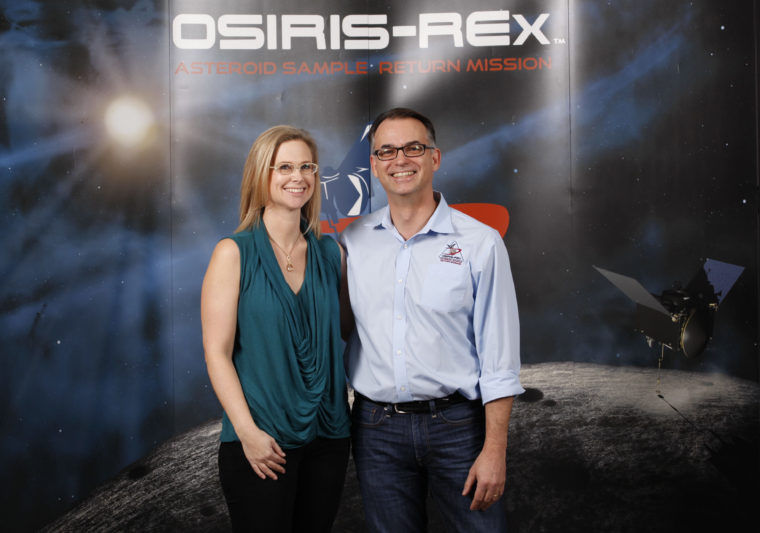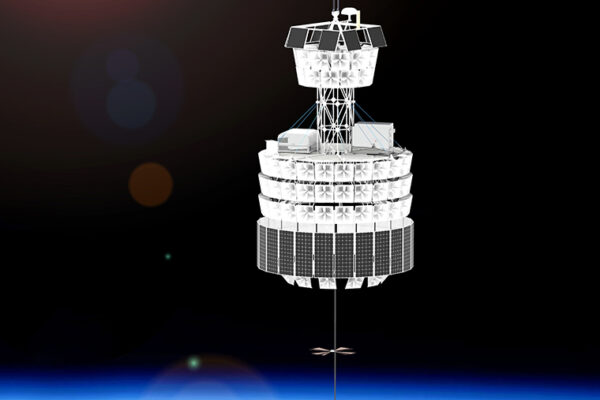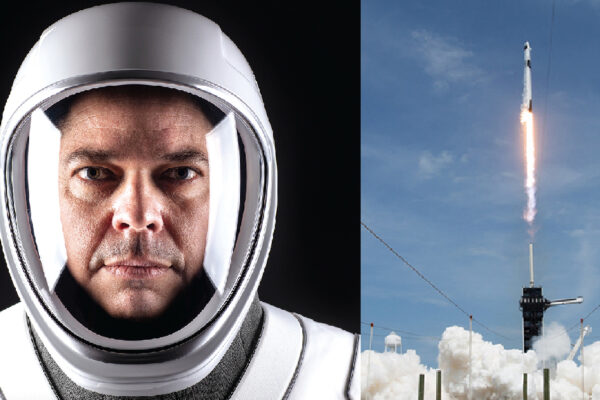On Sept. 8, 2016, as an Atlas V rocket fired up and away from Cape Canaveral on a seven-year journey to collect and return samples from the carbon-rich surface of the Bennu asteroid, two Washington University alumni on site sat anxiously watching the liftoff.
Mission chief Dante Lauretta, PhD ’97, and project data archivist Kate Crombie, PhD ’97 — the husband-and-wife team who met while in graduate school in earth and planetary sciences in 1993 — had a lot riding on that rocket: 12 years of intense, time-consuming work on NASA’s OSIRIS-REx mission.
“We had the SpaceX explosion a mile away from us a week before the launch. That provided a pretty stark reminder of the risk associated with the business we’re in,” Lauretta says. “We fortunately had a flawless countdown. I just froze, held my breath, watched the rocket go, and wished it Godspeed.”
Crombie describes the launch as “kind of nerve-racking. The entire team has been working on the OSIRIS-REx launch since 2004.”
Lauretta, professor of planetary science and cosmochemistry at the University of Arizona’s Lunar and Planetary Laboratory, is keen on understanding the origins of the solar system and life on Earth. The 2-ounce sample scooped up by the OSIRIS-REx space craft from the surface of Bennu, a 500-meter-wide near-Earth asteroid orbiting the sun in an elliptical path not unlike the Earth’s, may provide clues.
“We’re particularly interested in organic molecules and the role asteroids like Bennu may have played in seeding the surface of early Earth with the precursors for life.”
— Dante Lauretta
“We’re looking at Bennu as a time capsule from the very beginning of solar system formation,” he says. “Based on our telescopic data, we believe it is rich in carbon, and that’s the prime reason it was chosen as a target for our mission. We’re particularly interested in organic molecules and the role asteroids like Bennu may have played in seeding the surface of early Earth with the precursors for life.”
But collecting that sample still requires work, Lauretta says. “It’s not like I just sit back and wait for this pebble to come back. We have to fly the spacecraft. We will control it while exploring the asteroid, mapping the asteroid, selecting the site and getting the sample. That’s going to be a pretty intense and fun set of years.”
Meanwhile, Crombie will be working to ensure that all data collected by the project will be available to the scientific community through NASA’s planetary data system. She is president of Indigo Information Systems, which performs work for NASA and others, such as Japan’s space agency, JAXA.
“The data that come back from these missions is our national treasure,” Crombie says. “On OSIRIS-REx we have the additional bonus of bringing samples back, but with most missions only data come back. My job is to make sure that the flight data are properly formatted and comply with NASA standards. We have to work very carefully to make sure it’s all preserved and useful for future generations of scientists.”
Crombie and Lauretta aren’t the only ones from WashU’s earth and planetary sciences department making a mark, Lauretta says. “If you were to look across the classes graduating from Washington University in the late 1990s, you would see a lot of leaders in planetary science today. My colleagues have all gone on to successful professional careers, so WashU is certainly doing something right.”
Key to that successful learning, Lauretta believes, was the collegial culture of the department. “All of us were on a first-name basis. Nobody was professor so-and-so. They treated us like peers and colleagues. I had a lot of fun, got some great research done and really launched my career from there.”
Crombie concurs, singling out her prime mentor, Raymond E. Arvidson, the James S. McDonnell Distinguished University Professor, and his group as crucial to her career. “Being in Ray’s group and seeing people doing different pieces of the space-mission work puzzle were really important. It showed me the breadth of skills needed to do one of these missions.”
Rick Skwiot is a freelance writer based in Key West, Florida.



